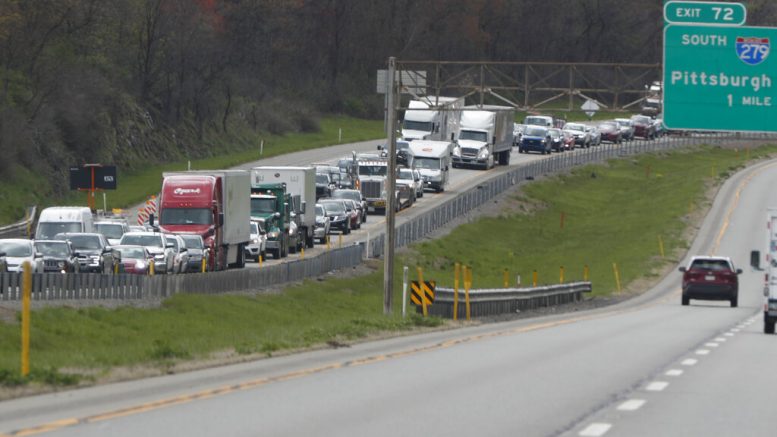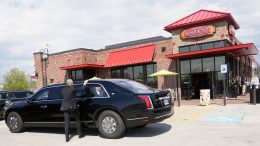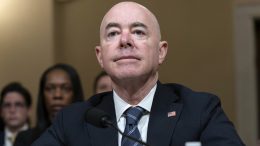HARRISBURG (AP) — About 1.5 million Pennsylvania residents will be able to freely leave their homes next week, and retail shops and other businesses will be able to reopen, as Gov. Tom Wolf on Friday lifted some pandemic restrictions on 24 largely rural counties.
All of the counties moving from “red” to “yellow” in Wolf’s color-coded reopening plan are in the northwest and north-central regions of Pennsylvania, which have seen far fewer coronavirus infections and deaths than most of the rest of the state. Included are Erie and State College. The most heavily populated areas, including Philadelphia and Pittsburgh, will remain locked down, Wolf said.
The changes are to take effect next Friday, May 8. Stay-at-home orders will be lifted, gatherings of up to 25 people will be allowed, and retail shops can start to reopen, though gyms, barber shops, nail salons, casinos, theaters and other such venues will remain closed and other restrictions will remain in place, including a ban on youth sports.
“Every Pennsylvanian should feel proud of the work we all did to flatten this curve, and every Pennsylvanian should take this moment to feel motivated by the success that we have had,” said Wolf, who nevertheless urged vigilance by residents and businesses to prevent an outbreak that could lead him to issue new shutdown orders in the areas where they’re being lifted.
“They must continue to abide by the underlying message of yellow: Proceed with caution,” Wolf said at a video news conference.
The counties where pandemic restrictions will be eased are: Bradford, Cameron, Centre, Clarion, Clearfield, Clinton, Crawford, Elk, Erie, Forest, Jefferson, Lawrence, Lycoming, McKean, Mercer, Montour, Northumberland, Potter, Snyder, Sullivan, Tioga, Union, Venango and Warren.
Counties in the Pittsburgh area and some in south-central Pennsylvania could be next to see an easing of restrictions, Wolf said, though he did not offer a timetable.
His administration also revealed details Friday about its strategy for mass testing — establishing a goal that 250,000 people are tested each month, up from about 180,000 currently — and released a contact tracing plan to contain fresh outbreaks, though health officials did not say how many tracers will be required to cover a state with 12.8 million people. Contact tracers identify people whom COVID-19 patients have been in contact with so they can be tested and isolated.
Smartphone users will be able to enroll in a voluntary program that will use Bluetooth technology to determine who may have come into contact with someone infected with the virus. It will send an alert to that smartphone if it was within a certain range of the infected user’s phone for a certain period of time, according to the Health Department. Officials did not say when the program will be deployed.
Wolf has said that shutdown measures he ordered starting in March have succeeded in preventing hospitals from becoming overwhelmed with patients with COVID-19, the disease caused by the virus. New infections have been trending down in many counties.
An analysis by The Associated Press shows that only 27 of the state’s 67 counties reported too many new virus cases over the past two weeks to qualify for a gradual easing of restrictions under Wolf’s reopening plan. But Wolf has grouped the state’s counties into six geographic regions, and health officials are also looking at regional case counts as they decide which counties merit consideration.
Health officials also say the incidence of new cases isn’t the only metric they’re looking at. Expanded virus testing, sufficient hospital capacity and the ability to quickly identify and contain flare-ups through contact tracing must also be in place.
The coronavirus has infected 47,000 Pennsylvania residents and killed more than 2,300, according to the latest Health Department statistics, while the state’s efforts to contain the virus have caused economic devastation, throwing nearly 1.7 million Pennsylvania residents out of work since mid-March.
Schools statewide remain closed for the rest of the academic year, and visitation restrictions on prisons and nursing homes remain in place. Wolf’s administration will continue to recommend that people wear masks in public, and mandate that businesses and commercial buildings that serve the public deny entry to customers not wearing them.
Meanwhile, Wolf has begun loosening some restrictions on business sectors. On Friday, golf courses, marinas, guided fishing trips and privately owned campgrounds statewide were permitted to reopen, and construction work was permitted to resume.
In other coronavirus-related developments:
POULTRY PLANT PROTEST
A car caravan of activists protested Friday outside the facilities of a Lebanon County poultry processor where they say dozens of workers have been infected with the coronavirus.
At least one worker at Bell & Evans has died, and the husband of another worker who tested positive also died, according to Make the Road Pennsylvania, an advocacy group for Hispanic immigrants, which is advocating on behalf of the plant workers.
Activists say the family-owned company has failed to keep workers safe and hasn’t been transparent about the extent of the outbreak. They want the plant shut down for cleaning, among other demands.
“Bell & Evans has failed to protect these workers and that failure cost their lives,” said Maegan Llerena, the group’s executive director.
An email was sent to the company seeking comment.
Meat and poultry processing facilities around the country have been stricken by the virus. The outbreak temporarily closed at least four meat processing plants in Pennsylvania.
CASES
Pennsylvania’s COVID-19 death toll rose by 62 to 2,354, the state Health Department reported Friday.
About 1,200 additional people tested positive for the virus that causes the disease, bringing the statewide total to about 47,000, according to the department.
The number of infections is thought to be far higher because many people have not been tested, and studies suggest people can be infected with the virus without feeling sick. There is no data on how many people have recovered.
For most people, it causes mild or moderate symptoms that clear up in a couple of weeks. Older adults and people with existing health problems are at higher risk of more severe illness, including pneumonia, or death.










































